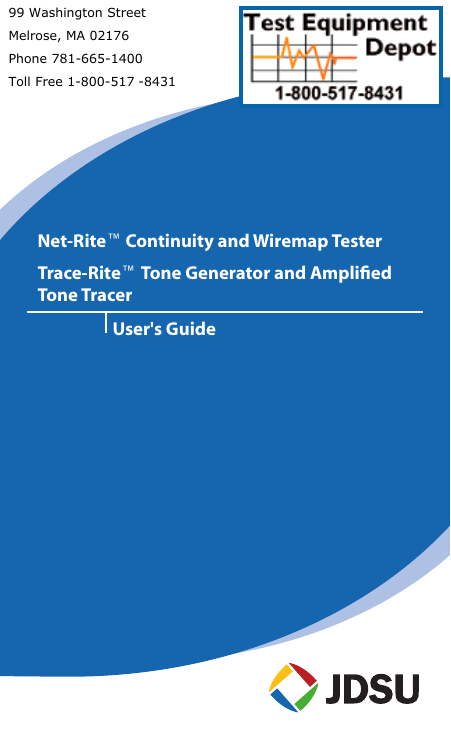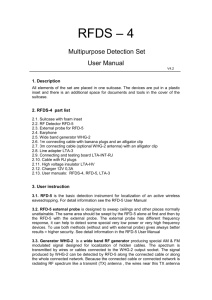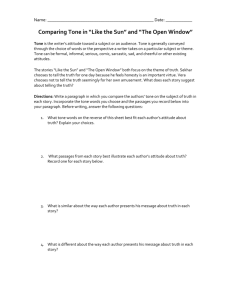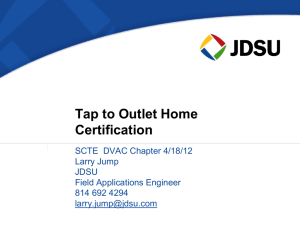User's Guide Net-Ritef Continuity and Wiremap Tester Trace
advertisement

99 Washington Street Melrose, MA 02176 Phone 781-665-1400 Toll Free 1-800-517 -8431 Net-Ritef Continuity and Wiremap Tester Trace-Ritef Tone Generator and Amplified Tone Tracer User's Guide Voltage Probe Tracer/Power Button Volume Up/Down Indicator LED Power/Tone Type Switch RJ11 RJ11 LCD Screen Remote RJ11 Warning! Do not attach to AC power, this may damage the Net-Rite™ and the Trace-Rite™ generator and could cause a safety hazard for the user. Caution! Improperly crimped, damaged or un-crimped plugs can damage the jack on the NetRite™ and Trace-Rite™. Inspect plugs for proper termination and crimping before inserting into the tester. Contacts should always be recessed into the plastic grooves of the plug. Features Net-Rite™ Features • Auto-on when sensing the remote or a short • Auto-off when the remote is disconnected to conserve battery life • Ergonomic shape, with soft edges • When not in use, the remote stores in the bottom of the main unit Trace-Rite™ Features • Self-powered Amplified Probe on the Tone Tracer turns on when tone sensor button is depressed and off when the button is released • Compact Tone Generator turns off automatically when stored in the bottom of the Tone Tracer to conserve battery life • Ergonomic shape with soft edges • Two selectable tone styles with LED indicator • Changeable Round Tip Probe • Adjustable Volume control Instructions for Use To Wiremap a Cable 1) Using the RJ45 jacks, connect Net-Rite™ main unit and remote to the cable you want to test. ) An icon and the wiremap are always displayed. Net-Rite™ reports: a) PASS when the cable pins are properly connected per T568A/B and there are no other faults, or b) an error icon when it does not pass. Pins with errors flash an error message: Miswire, Split, Open, Short, or Reverse. To Trace a Tone 1) Using the RJ12 jack on the remote, connect the Trace-Rite™ Tone Generator to the cable to be traced. ) Slide the Tone Generator switch up to select one of the two tones (stutter tone or fast stutter tone). The green LED lights and flashes intermittently to indicate the tone generator is powered on and which tone speed has been selected. ) Press and hold the black button on the Amplified Probe to turn on the probe. 4) Adjust volume control on the side of the Trace-Rite™ to a comfortable level. If the signal is very loud when near the cable, adjust the volume to avoid overloading the Trace-Rite™. When overloaded, small increases or decreases in the signal at the tip cannot be heard. 5) Hold the tip of the Trace-Rite™ near the cable to be identified. The signal will be loudest on the wire or cable attached to the generator. Separating the wires or cables may help in isolating the correct cable. Interpreting Wiremap Errors Miswire—One or more pins or pairs are not connected to the correct pins at the other end of the cable, i.e., one-to-one—pin 1 to pin 1, pin 2 to pin 2, etc. Split—A split pair is an error in the twisting of the wires together within the cable. The cables generally are made up of eight wires twisted together in 4 pairs. These 4 pairs are designated as pairs by the wiring standards and are intended to carry a signal and its return. 1 & 2, 3 & 6, 4 & 5 and 7 & 8 are the pairs designated by T568A/B for a RJ45 jack or plug. A cable can be wired with correct continuity, but not with correct pairing. This often happens when the cable is terminated consistently at both ends, but in the wrong order. A dynamic or AC test is required to detect this type of error. If the only error is a split pair error, the cable has correct continuity. If cross talk is not a concern, as in flat satin cable, the cable is good if the only error is the split pair error. Open—The pair is not connected. Short—The pair has a low resistance connection between wire pairs or the shield. The wire pairs involved displays on the LCD screen. Reverse—A reverse (Rev) pair is a special case of a Miswire, and both icons will be flashing. The wires are connected to the correct pair of pins, but the two leads are reversed. Voltage—When voltage is detected on any of the pins, lightning bolt icons flash. Disconnect from the cable as soon as possible. GREY=FLASHING Passing Shielded Cable 4-5 Pair Open 1-2 Short 3-4 & 4-5 Split Pair 2 & 3 Miswired Battery Installation Net-Rite™ 1) Using a #1 Phillips screwdriver, unscrew and remove the battery door. ) Remove old cell batteries. Rapping the case against the palm of the hand will help dislodge the batteries. ) Install 4 new LR44 cell batteries, orienting the plus end of battery with the plus symbol on case. 4) Replace battery door and reinsert the screw. Do not over tighten. Trace-Rite™ 1) Remove the screw at the back of the Tone Generator or Amplified Probe with a #1 Philips screwdriver and remove battery door. ) Remove old coin batteries. Rapping the case against the palm of the hand will help dislodge batteries. ) Install 4 new LR44 cell batteries being careful to orient plus end of battery with plus symbol on case. 4) Replace battery door and reinsert the screw. Do not over tighten. To Replace the Probe Tip 1) Using a #1 Phillips screwdriver, remove the screw on the back of the Trace-Rite™ nearest to the probe. ) Pull the tip out of the top. ) Push the new tip into the top. 4) Replace the screw and tighten, being careful not to over tighten. 10 Models, options & accessories Description Ordering number Net-Rite continuity and wiremap tester and Trace-Rite tone generator with onboard probe kit KP260 Net-Rite continuity and wiremap tester TP250 Trace-Rite tone generator with on-board probe TT250 11 Net-Rite™ Specifications Physical Dimensions Size: 11.3 x 5 x 2.7 cm (4.5 x 2 x 1.1 inches) Weight: 100 grams (3.5 oz.), with battery and remote Environmental Operating temperature: 0 to 50˚C (32 to 122˚F) Storage temperature: –10 to 60˚C (14 to 140˚F Humidity: 10% to 90%, non-condensing Power Requirements Four (4) LR44 button cells (6 volts) Battery Life (6V alkaline battery, typical) times are for the full capacity of the battery Used continuously in one of the following modes Standby: 2.5 years Cable Testing: 150 hours Externally applied voltage without damage: 250 volts peak DC or 175 volts RMS AC for 5 seconds, 100Vdc or 70Vac RMS continuous Cable Types Shielded or unshielded CAT6, CAT5, CAT5E, CAT4, and CAT3 Minimum cable length for testing for split pairs: 1 meter (3 feet) 12 Trace-Rite™ Specifications Physical Dimensions Size: 20.6 x 4.45 x 3.0 cm (8.1 x 1.75 x 1.2 inches) Weight: 113 grams (4 ounces) Environmental Operating temperature: 0 to 50o C (32 to 122o F) Storage temperature: -20 to 60o C (-4 to 140o F) Humidity: 10% to 90%, non-condensing Power Requirements Four (4) LR44 button cells (6 volts) Battery Life (6V Alkaline battery, typical) times are for full capacity of the battery Used continuously: Tone Generator: 50 hours Tone Tracer: 10 hours Externally applied voltage without damage 250V DC or 175V RMS AC Tone Frequencies (+/- 5%): 970Hz and 825Hz alternating tones Tone Voltage: 12 volts peak-to-peak no load, new battery Tone Power: 8.9 dbm into 600 ohms, new battery 13 Customer Services This section provides a description of customer services available through JDSU (including returns policies and procedures) and warranty information. Customer Service (Standard Services) Customer Service accompanies the sale of every JDSU product. Customer Service services include: • Technical Assistance (Business Hour) • Instrument Repair (Under Warranty Repair, Calibration Services, and Upgrade Services) • Immediate Return Authorizations Technical Assistance Expert business hour technical support is included with your product. Instrument Repair Our service centers provide repair, calibration, and upgrade services for JDSU equipment. JDSU understands the impact of equipment down time on operations and is staffed to ensure a quick turnaround. Available services include the following: Product Repair — All equipment returned for service is tested to the same rigorous standards as newly 14 manufactured equipment. This ensures products meet all published specifications, including any applicable product updates. Calibration — JDSU’s calibration methods are ISO approved and based on national standards. Factory Upgrades — Any unit returned for a hardware feature enhancement will also receive applicable product updates and will be thoroughly tested, ensuring peak performance of the complete feature set. Equipment Return Instructions Please contact your regional Technical Assistance Center to get a Return or Reference Authorization to accompany your equipment. For each piece of equipment returned for repair, attach a tag that includes the following information: • • • Owner’s name, address, and telephone number. The serial number (if applicable), product type, and model. Warranty status. (If you are unsure of the warranty status of your instrument, contact Technical Assistance.) 15 • A detailed description of the problem or service requested. • The name and telephone number of the person to contact regarding questions about the repair. • The return authorization (RA) number (US customers), or reference number (European Customers). If possible, return the equipment using the original shipping container and material. If the original container is not available, the unit should be carefully packed so that it will not be damaged in transit; when needed, appropriate packing materials can be obtained by contacting JDSU Technical Assistance. JDSU is not liable for any damage that may occur during shipping. The customer should clearly mark the JDSUissued RA or reference number on the outside of the package and ship it prepaid and insured to JDSU. 16 Warranty Information JDSU guarantees that its products will be free of all defects in material and workmanship. This warranty extends for the period of 12 months for test instruments and 3 months for cables from date of manufacture or purchase (proof of purchase required). All product deemed defective under this warranty will be repaired or replaced at JDSU’s discretion. No further warranties either implied or expressed will apply, nor will responsibility for operation of this device be assumed by JDSU. WEEE Directive Compliance JDSU has established processes in compliance with the Waste Electrical and Electronic Equipment (WEEE) Directive, 2 002 /96/EC. This product should not be disposed of as unsorted municipal waste and should be collected separately and disposed of according to your national regulations. In the European Union, all equipment purchased from JDSU after 005 -08 -13 can be returned for disposal at the end of its useful life. JDSU will ensure that all waste equipment returned 17 is reused, recycled, or disposed of in an environmentally friendly manner, and in compliance with all applicable national and international waste legislation. It is the responsibility of the equipment owner to return the equipment to JDSU for appropriate disposal. If the equipment was imported by a reseller whose name or logo is marked on the equipment, then the owner should return the equipment directly to the reseller. Instructions for returning waste equipment to JDSU can be found in the Environmental section of JDSU’s web site at www.jdsu.com. If you have questions concerning disposal of your equipment, contact JDSU’s WEEE Program Management team at WEEE.EMEA@jdsu. com. 18





